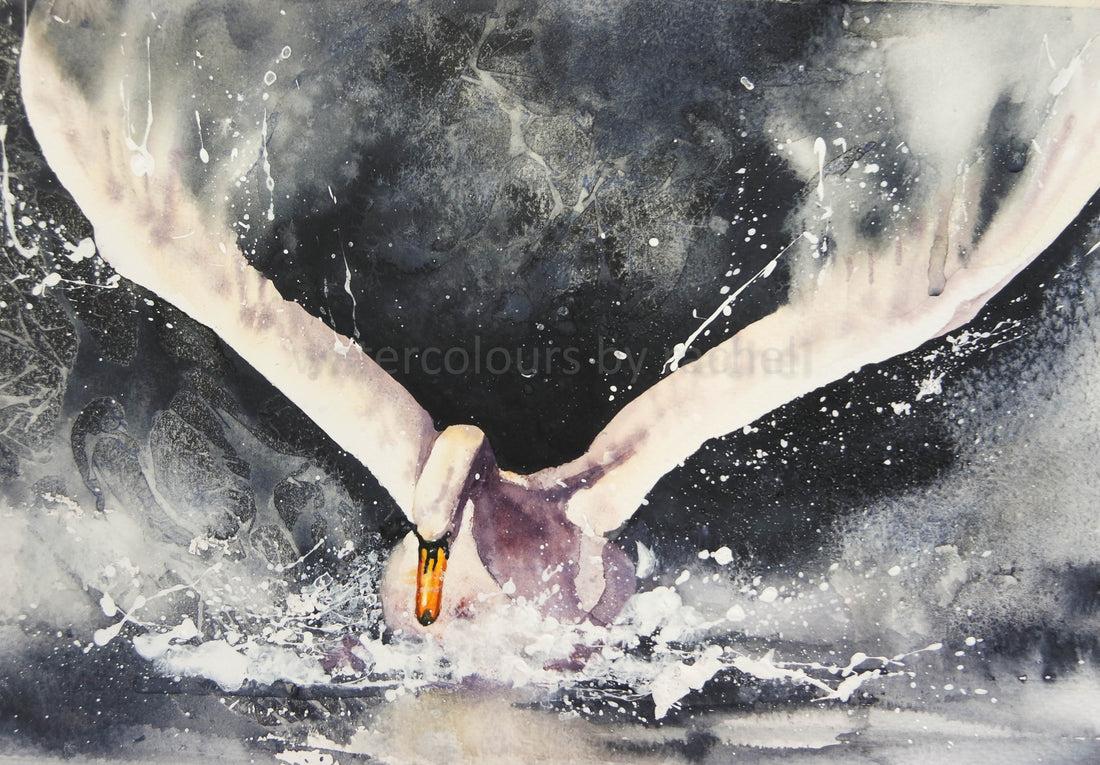I am flattered and amazed by the response I had to my latest swan piece.

I looked back and saw I have been painting swans in this way since about 2015. I think you'll agree the end result has improved since the early days but the process is still similar so I thought you might be interested in this blog from 2016.
I try to write a blog each week, but sometimes, work, family, appointments get in the way, but for anyone reading this for the first time, please be aware I have many blogs reaching back to 2016 , and they are a resource for any budding watercolourist who wants to read them. So far I have managed to keep them free and accessible to all.

So as the much needed rain pitter patters down on my studio roof, like it was in 2016 here is how I painted a swan x
So on a rainy Saturday I decided to get messy and have fun painting a swan landing on water. I have tried to photograph the painting in stages so you can see how I did it...
1. Draw a the swan ( I use bockingford watercolour paper and an A2 pencil)

2. Now I literally splatter and flick masking fluid where I imagine the splashes of water to be.....

I use a colour shaper tool, which is made of a type of rubber and stops me from ruining my brushes.
3.Here is the paper, the masking fluid is a yellow colour, I shake the board around too and move the masking fluid on the paper...just have fun.

4. You have to let the masking fluid dry completely, have a cup of tea, think about the painting but make sure it is dry, Now I paint the details of the swan's head, and use the only colour apart from Payne's grey . The beak is yellow ochre, cadmium orange. and some cadmium red..... I also add some shadows to the swan's body and wings.....

5. Once the swan is painted I load a lot of paynes grey onto my brush and carefully think about where I want a crisp line between the swan and the grey to be.Then where I want it to blend. I want to convey movement so I don't want a solid colour behind the swan and I want it to look like water. There is a lot to think about and I don't want the wash to dry....

6.I try to break up the background too, by flicking water on the page and using a weaker wash then a stronger one....This is where the painting is going thick and fast and I have to concentrate hard

7. So I stand back from what is happening, add water and take it away, thinking about mark making, and what I like and don't like. Then I have to leave it to dry. I flick some white acrylic into the wet wash and into the splashes and from the wings to give a feeling of movement.....now it has to dry thoroughly .As you can see it is a messy business but one I love

8. Now when it is dry, time to rub off the masking fluid. I use a rubber to do this, and when that is done I go back in with some paint and water to soften edges and cover some splashes I don't like the position of. Now to stand back and decide that the painting is done


4 comments
Dear Rachel, I bought myself your RNLI bird calendar this year…….I could not resist your beautiful paintings. You have inspired me to dig out my old paints an have another go. Thank you so much. Jill from West Cornwall xx
Sie inspirieren mich auch Tiere in ihrer Bewegung zu malen. Besonders gefallen mir ihre Anleitungen, so versuche ich Bilder nachzumalen, heute Ihren Schwan. Ganz lieben Dank, dass Sie die Entstehung Ihrer Bilder mit uns teilen.
Someone posted on FB your " am I too old…" and I loved it. From there discovering your other art work and saving some. Because I have tried to do water color, but need to be much looser. Not too finished or perfect. I esp like some of your backgrounds, like the two polar bears! Loved reading your explanation how you came to paint the swan. I’m saving both of them too. THANK you!
Thank you for sharing this with us. I am going to paint some swans after reading your blog.